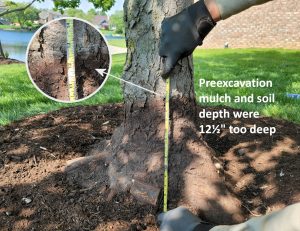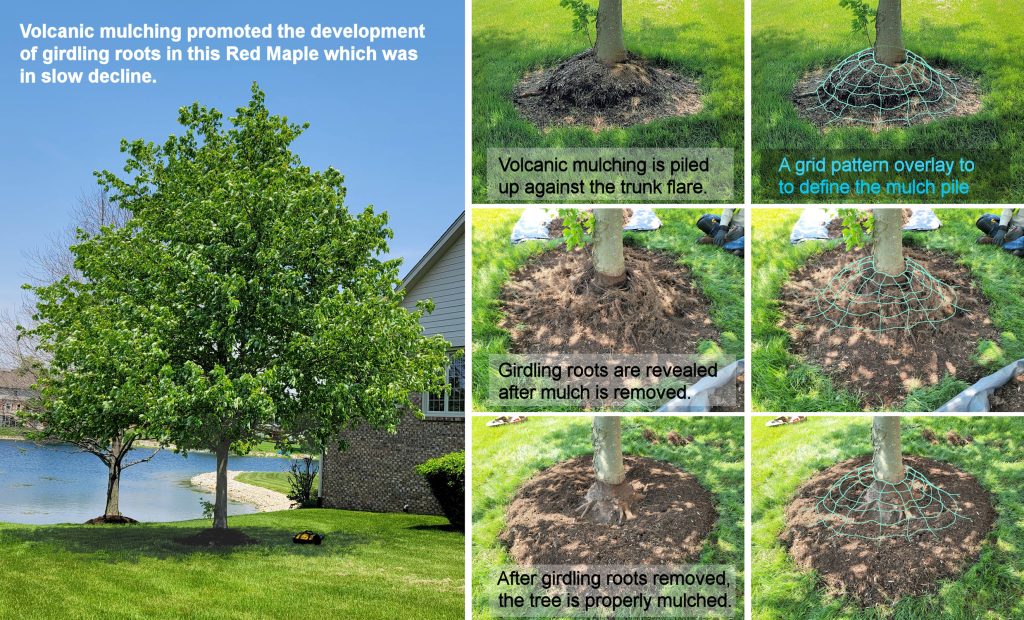[Last update: November 2025]
Quick Links to Topics Covered in This Article:
INTRODUCTION • Mulching Can Be a Hassle, So WHY Do It?
Mulch – What Is It and Why Beneficial? • Properly Applied Mulch
AVOID Volcanic Mulching!
INTRODUCTION: MULCH: The Ugly, The Bad, and The Good
Most property owners are conscientious about the appearance of their landscapes. They will spend hundreds, even thousands of dollars to enhance their property’s “curb appeal.” This is particularly the case if they want to build equity in their property and perhaps sell their home in the future. A properly maintained property with a healthy-looking lawn and a complement of aesthetically pleasing trees, shrubs, and flowers can do wonders for it’s value!

Properly applied mulch in the landscape can produce environmental benefits and add value and aesthetics to your property!
In many landscapes, mulch plays an important role in adding balance and beauty to the landscape, but not everyone views mulch from the same perspective. Instead of being a happy marriage that joins aesthetics with functionality, aesthetics appears to take top priority, but in many cases is not applied properly! This is primarily where some major plant health care (PHC) problems develop in the landscape. This article will discuss a few common types of mulch used (the ugly, the bad, and the good), the benefits of properly applied mulch from a practical scientific viewpoint, and how improperly applied mulch can cause irreparable harm to your trees and shrubs.
Mulching Can Be a Hassle, So WHY Do it?
Let’s face it. Mulching can be a pain to have to do every year, and some property owners simply don’t like trouble and time it takes to do it themselves. There are many who don’t use mulch around their property at all and will let grass grow around the base of their landscape trees. That’s their decision, and it’s okay, but some safeguards are advised.

Lack of mulch around this mature tree resulted in the mower service severely damaging the trunk flare repeatedly over several years. This tree eventually died from these injuries and was taken down.
Often plants lacking the protection of mulch will suffer injuries from weed-trimmers and mowing equipment (a.k.a., mechanical damage).
Sometimes ground covers, like ivy or euonymus vines, are used, but some of these crawling vines may have a tendency to creep up on plants, which can result in bark damage, crowding out sunlight, and strangling if left unmanaged.

Overgrown vines on trees can damage the bark, crowd out sunlight light, and strangle the trunk stem.
Alternatives to mulch have been very popular. A few well-meaning landscape designers have sold homeowners who dislike annual mulching and wanted another solution into using rubber mulch or stones in their landscape beds. Shredded rubber mulch (sometimes made from recycled rubber tires) can look very much like wood mulch, even upon closer inspection. The key benefit being promoted is that rubber mulch doesn’t break down like normal organic wood mulch, and, if used in playgrounds, for example, it’s a softer alternative, and kids wouldn’t get splinters. Ultimately, using rubber mulch means less frequent applications.
Stones like pea gravel, crushed pumice rock, riverbed rocks, and similar rocks have also been promoted for use in landscape beds. Many designer portfolios feature eye-catching landscapes with compellingly attractive pebble-covered landscape beds. The “bonus” again is that these stones don’t break down like organic mulch, and that immediately translates into no annual reapplications.
While it is true that non-organic mulches save time and effort of having to reapply every year, all too often, the greater benefits of organic mulching, as discussed in the next section, are overlooked or ignored.
Mulch is any material, organic or inorganic, that is spread on the soil’s surface in a landscape to conserve moisture, suppress weeds, moderate soil temperature, and improve appearance. Common organic mulches include wood chips, bark, straw, and leaves, which break down over time and add nutrients back into the soil. Inorganic options include gravel, rocks, or rubber, which can last longer but don’t improve soil quality. These types of materials are mostly for “looks” (a.k.a., curb appeal). Which type of mulch you choose depends on the aesthetic results you want to achieve, and while doing so, whether you also desire to improve the soil quality for your landscape plants or simply want a longer-lasting ground cover. Either choice will still require maintenance again when weeds reappear.
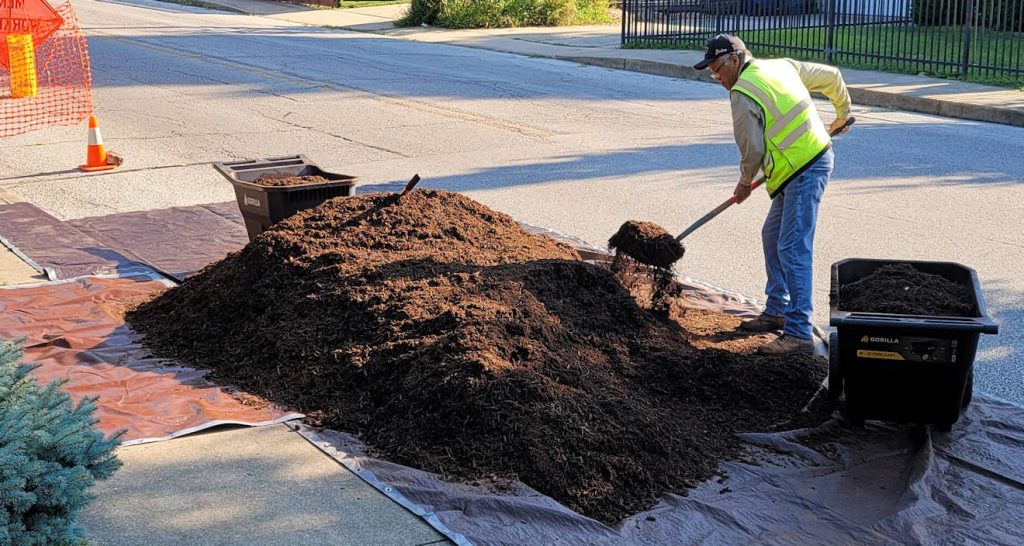
Hardwood mulch (wood chips) is a common organic material used for landscaping and has additional benefits when properly applied.
Key functions of mulch in a landscape: The Benefits of Mulch
-
- Moisture conservation: A layer of mulch reduces water evaporation from the soil.
- Weed suppression: Mulch blocks sunlight, which helps prevent weed seeds from germinating.
- Temperature regulation: It helps keep soil cooler in the summer and warmer in the winter, protecting plant roots.
- Soil improvement: Organic mulches decompose, adding nutrients and improving soil structure over time. This is not a benefit produced by non-organic mulches.
- Erosion control: Mulch helps prevent soil from washing away due to heavy rain or foot traffic.
- Aesthetic enhancement: It provides a neat, finished look that contrasts with plants and can be chosen for specific visual effects.
In the following section, we are going to offer simple guidance on properly applying mulch around trees to gain the most benefits from using it in your landscape.
Properly Applied Mulch

This diagram displays recommended basic guidelines for the successful application of organic mulch materials.
Applying organic mulch correctly is key to a tree’s health, as improper mulching can cause rot, disease, and even damage to the trunk and its bark! Around individual trees, the “donut” (doughnut or mulch ring) method is recommended because it keeps the base of the tree at the trunk flare exposed (about a 2″ to 4″ gap), which will also minimize the development of girdling roots. The mulch should not be compacted, nor deeper than 4″. If cutting an edge around the mulch ring, use caution and avoid damaging the lateral roots underneath.
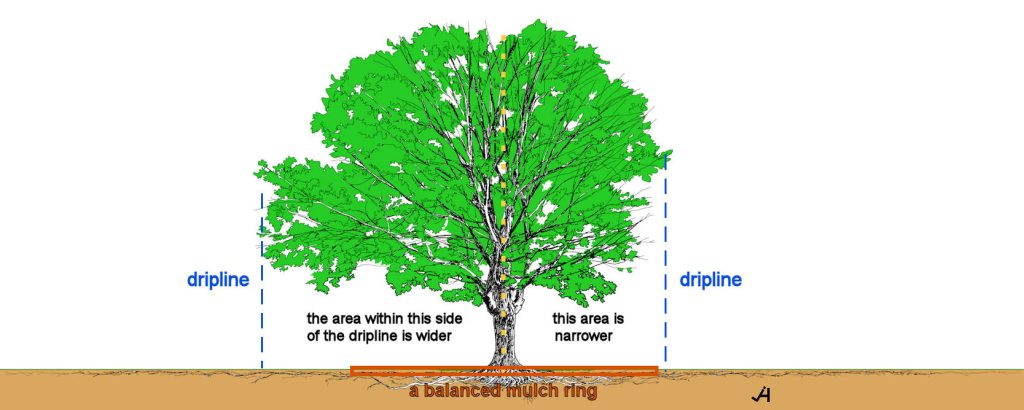
Base the diameter of your mulch ring on the dripline of the tree. Increase or decrease the diameter as best fits your property aesthetic needs.
The diameter of the mulch ring should be based on the dripline of the tree. For newly planted seedlings, this may be as little as 2 feet across, but the ring size can scale up to several feet for mature trees. Of course, each property is unique, and your preference of mulch ring size will have to balance with how much turfgrass you prioritize for your lawn, so determine the size of each ring for what works for your landscape. Note that not all tree canopies, that is, the limbs and foliage that make up the “crown” or upper portion of a tree, grow equally, and so portions of the tree may extend further than others. Therefore, if there is a difference in the radius from the center of the tree on one side and the radius from the center of the tree on another side, determine the mulch ring diameter using the shortest dripline radius from the central trunk as your guide to balance the mulch ring to improve aesthetics.
AVOID Volcanic Mulching!
Volcanic mulching around trees, which piles mulch against the trunk, can cause root rot, fungal diseases, and bark decay due to excessive moisture. It also leads to poor root growth, as roots may grow into the mulch instead of the soil, potentially causing them to girdle the tree. These issues weaken the tree, making it susceptible to pests, and can ultimately lead to decline and death.
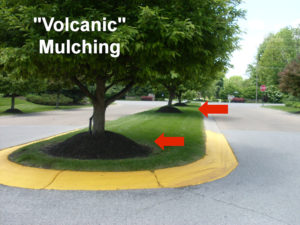
Ornamental crabapples that were meant to adorn this community’s common entrance were improperly mulched.
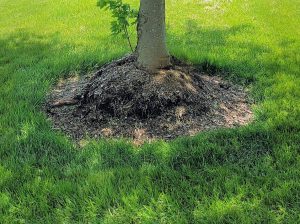
Volcanic mulching around trees can lead to trunk deterioration due to excessive moisture, among other problems.
Problems caused by volcanic mulching:
-
- Moisture and rot: Piling mulch against the trunk traps moisture, which can cause the bark to rot and decay. This opens the tree up to cankers and other diseases.
- Poor root growth: It encourages roots to grow into the mulch layer instead of spreading into the soil. These shallow, adventitious roots can then girdle the tree, strangling the root system and causing stress.
- Oxygen deprivation: A thick, dense layer of mulch can block oxygen from reaching the roots, especially if the soil is already poorly drained.
- Pest and disease habitat: The moist, decaying material provides an ideal environment for insects and rodents that can damage the tree.
- Hydrophobic mulch: In dry conditions, thick layers of mulch can become hydrophobic, meaning they repel water and prevent rain from reaching the roots.
- Heat damage: As mulch decomposes, it can produce heat that may damage the inner bark of young trees or interfere with the natural hardening-off process in the fall.
How to fix volcanic mulching:
-
- Pull back the mulch from the base of the trunk to create a 2″ to 4″ gap.
- Ensure proper depth by keeping the total mulch depth to a non-compacted 2″ to 4″, extending it out from the trunk based on the dripline.
- Expose the trunk/root flare. The flare is where the trunk widens before meeting the roots. This area should be visible, and if you discover girdling roots, many of these may be removed; however, we recommend consulting with a qualified certified arborist before performing any root pruning.
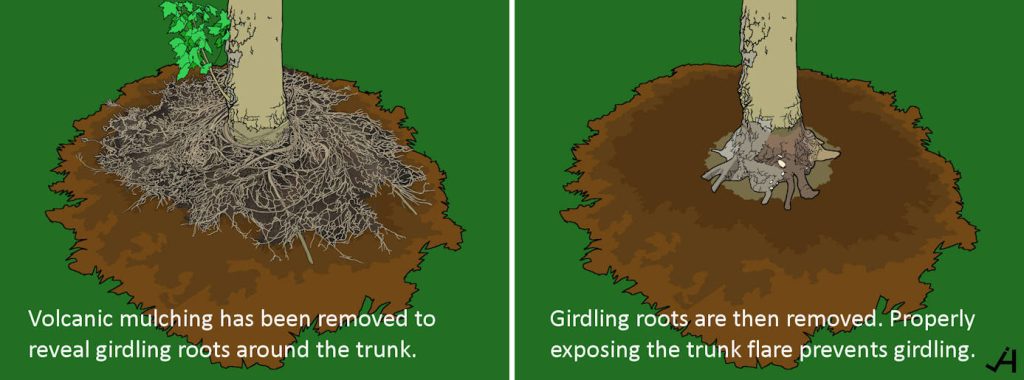
Removing volcanic mulch may reveal a surprising network of girdling roots! Seek professional advice before attempting to remove these girdling roots to minimize unnecessary injury to the tree.

